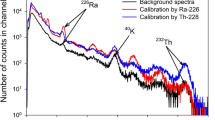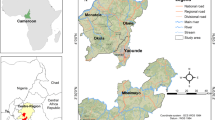Abstract
Radon α-activity concentrations have been measured inside and outside various building materials by combining a calculational method with the solid state nuclear track detector (SSNTD) technique. Radon emanation coefficients of the studied materials have been evaluated. A new calibration method for determining the radium (226Ra) and thorium (232Th) specific activities of the considered building materials has been developed. The radon production rates per unit volume of the studied materials have been evaluated. The influence of the material porosity on the radon emanation coefficient and radon production rate have been investigated.
Similar content being viewed by others
References
W. M. Lowder, Natural environmental radioactivity and radon gas, in: Radon Monitoring in Radioprotection, Environmental Radioactivity and Earth Sciences,L. Tommasino et al. (Eds), World Scientific, 1989.
J. P. McLaughlin, Proc. Intern. Workshop on Radon Monitoring in Radioprotection, Environmental and Earth Sciences, ICTP, Trieste, Italy, 1989.
C. Satif, M. A. Misdaq, Appl. Radiation Isotopes, 46 (1995) 365.
M. A. Misdaq, C. Satif, R. Charik, L. Oufni, Appl. Radiation Isotopes (1995) (in press).
M. A. Misdaq, C. Satif, J. Radioanal. Nucl. Chem., 198 (1995) 179.
L. Oufni, S. Manar, M. A. Misdaq, A. Kouttt, E. H. Chellai, M. Marzoqi, J. Radioanal. Nucl. Chem., 182 (1994) 367.
M. Rokmy, M. A. Misdaq, C. Satif, J. Radioanal. Nucl. Chem., 190 (1995) 51.
A. Azam, A. H. Naqv, D. S. Srivastava, Nucl. Geophys., 9 (1995) 653.
D. R. Kalkwarf, P. O. Jackson, J. C. Kuit, Health. Phys. 48 (1985) 429.
J. P. Biersack, J. F. Ziegler, Trim. Version 92, 1992.
M. A. Misdaq, H. Moustaaidine, C. Satif, R. Charik, Appl. Radiation Isotopes (1996) (in press).
E. Stranden, Health Phys., 38 (1980) 777.
K. P. Strong, D. M. Levins, Health Phys., 42 (1982) 27.
Author information
Authors and Affiliations
Rights and permissions
About this article
Cite this article
Misdaq, M.A., Moustaaidine, H. A new method for determining the radon emanation coefficients and radon production rates in different building materials using solid state nuclear track detectors. J Radioanal Nucl Chem 218, 9–12 (1997). https://doi.org/10.1007/BF02033966
Received:
Issue Date:
DOI: https://doi.org/10.1007/BF02033966




